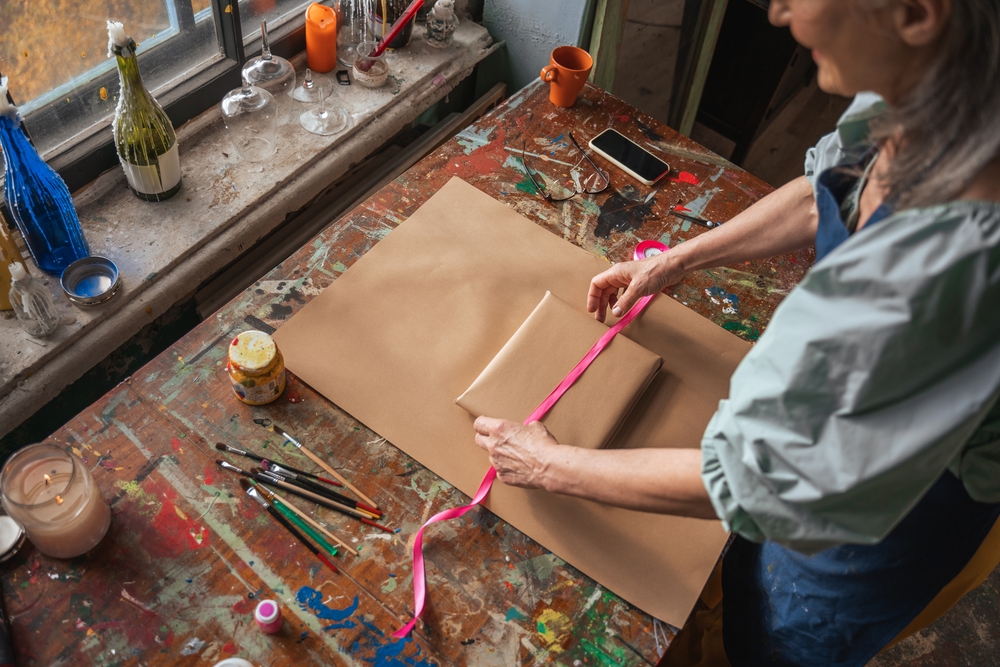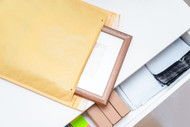Packaging Ideas for Art Prints
12th Dec 2023
As an artist or art seller, you understand that presenting and shipping your art prints in a secure manner is crucial to your success. In this blog post, we’ll explore various sustainable packaging ideas for art prints, customisation techniques, and protective measures to ensure your art prints arrive in perfect condition, creating a memorable unboxing experience for your customers.
The Basics of Art Print Packaging
Proper packaging of art prints helps maintain their sharpness and protects them from shipment damage. For watercolour paintings, for instance, you can opt for a layer or two of paper or plastic dust protection, followed by cushioning and packaging paper, and finally, corrugated pads or corner protectors to ensure the artwork arrives intact.
The first layer of packaging should be a plastic sleeve or dust protection to prevent scratches or smudges during transit. Shipping boxes that can be flattened provide cost-effective shipping and simplify storage.
When determining the level of protection for art prints during shipping, consider the worth and irreplaceability of the artwork. Selecting suitable packaging materials and using proper protection techniques ensures the safe and pristine delivery of your art prints.
Protective Measures for Shipping Art Prints
Ensuring your art prints arrive in perfect condition requires careful attention to padding, sealing, and cushioning techniques. The subsequent sections will discuss various protective measures such as adding extra padding, using sealing techniques to secure prints, and opting for fill and cushioning solutions to prevent movement and damage during transit.
Extra Layer of Padding
Adding an extra layer of padding to protect art prints during shipping is essential to avoid potential damage. An additional layer ensures protection against:
- Bending or creasing
- Scratches or scuffs
- Moisture damage
- Impact damage
- Frame or corner damage
Without additional padding, art prints may be susceptible to these types of damage, potentially diminishing their value and disappointing your customers.
The suggested thickness of padding for shipping various sizes of art prints can vary depending on the source, but it’s recommended to use robust packaging materials such as double-walled corrugated cardboard pads or foam boards that are a minimum of 2 mm to ½ inch thick. This provides adequate protection for the art prints during shipping, ensuring they arrive in pristine condition.
Sealing Techniques
Proper sealing techniques help keep art prints secure and protected from dust, dirt, and smudges during transit. Some popular sealing techniques include:
- Self-sealing bags: these utilise a peel-off strip that reveals a sticky band, allowing for a secure seal when the flap is folded over.
- Sealing tapes: these can be used to seal the edges of the packaging, providing an extra layer of protection.
- Plastic sleeves: these can be slipped over the art print to protect it from damage.
By using these sealing techniques, you can ensure that your art prints arrive in pristine condition.
When choosing sealing tapes, opt for removable double-sided tape, packaging tape, or Tyvek tape for their effectiveness in securing art print packaging. Properly sealing your art prints aids in their protection and preservation during transit, ensuring your customers receive their purchases in flawless condition.
Fill and Cushioning
To prevent movement and damage during transit, recommended materials for fill and cushioning include:
- Bubble wrap
- Acid-free tissue paper
- Protective foam sheets
- Thick bubble wrap
- Cardboard shipping tubes
- Packing tape
For optimal protection, it’s advised to use cushioning materials such as bubble wrap or packing peanuts and ensure the packaging has a minimum of 2 inches of cushioning on all sides of the art prints. Filling any vacant space in the packaging helps prevent movement and potential damage, ensuring your art prints arrive safely and in perfect condition.

Creative Packaging Enhancements
Beyond protection and sustainability, considering creative packaging enhancements can make your art print packages more distinctive and delightful for your customers. The following sections will examine DIY decorative elements like patterned paper and ribbon, as well as the integration of the artwork itself into the packaging design.
DIY Decorative Elements
Custom stickers and tapes, handmade packaging with creative designs, unique packaging design ideas, templates for simple rectangular boxes, decorative wraps and handles for cardboard boxes, and hangtags, labels, belly bands, and inserts are some simple DIY decorative elements for packaging. Custom patterned paper can also be created by importing a seamless pattern from an online shop like Creative Market and designing your packaging paper using the pattern and any other elements you wish to include.
Techniques for tying a decorative ribbon on packages include:
- Wrapping the ribbon around the package and securing it with double-sided tape
- Making a loop with the ribbon and tying a knot around the package
- Twisting the ends of a wire ribbon to secure it on the package
- Tying multiple ribbons around the centre of the package to create a layered bow
These DIY decorative elements can help make your art print packaging more visually appealing and memorable.
Step-by-Step Guide to Packing Art Prints
With a clear understanding of various packaging options and techniques, the next step is to learn the process of packing art prints. The subsequent sections will outline the steps of:
- Measuring
- Cutting
- Layering
- Wrapping
- Sealing
These steps will ensure the safe and secure shipping of your art prints.
Measure and Cut
Accurately measuring and cutting packaging materials is essential for ensuring the proper fit and protection of your art prints during shipping. Here are the steps to follow:
- Use a tape measure, a cutting tool (such as a utility knife or scissors), and a putty knife for precise cuts.
- To measure your art prints, secure each side with smaller pieces of tape to prevent movement.
- Measure the height, width, and depth of the pre-wrapped artwork.
- Weigh the artwork if necessary.
- Based on the measurements, select the appropriate packaging materials and box size.
When cutting packaging materials, follow these guidelines to ensure protection:
- Leave an extra inch of space around the print.
- Avoid common errors such as incorrect sizing and spacing, missing or incorrectly placed crop marks, inadequate setup for bleeds, and not measuring end-use materials prior to ordering.
- Accurate measuring and cutting of your packaging materials ensure the safe delivery of your art prints.
Layering and Wrapping
Layering and wrapping are essential for ensuring your art prints are securely packaged and protected during shipping. To layer and wrap your prints, follow these steps:
- Start with a layer of acid-free tissue paper.
- Place one or two layers of tissue paper over the print.
- Add additional triangles of tissue paper to each corner of the print for extra protection.
- Incorporate foam layers surrounding the print to provide cushioning.
- Finally, wrap the entire package in a layer of polythene to create a waterproof seal and secure the package with high-quality packing tape.
Proper layering and wrapping of your art prints aid in their protection and preservation during transit, ensuring your customers receive their purchases in impeccable condition.
Final Inspection and Sealing
Before shipping your art prints, conduct a final inspection to ensure a polished and professional presentation. This includes:
- Proofreading and spell-checking
- Artwork inspection
- Verifying the packing list
- Packaging inspection
- Assortment check
To seal your art print packages, you can use the following methods:
- Use “do not bend” envelopes with cardboard backing
- Seal plastic sleeves with adhesive
- Use durable cardboard and quality tape
- Package prints in clear archival bags
- Use glassine paper and wax seals for extra protection
- Seal wrapping with packing tape or stickers
Conducting a thorough final inspection and securely sealing your art print packages shows your attention to detail and dedication to providing a professional presentation for your customers.
Properly packaging and shipping your art prints is crucial for maintaining their quality and creating a memorable experience for your customers. By selecting sustainable packaging materials, incorporating personal touches through customisation, and implementing protective measures such as padding, sealing, and cushioning, you can ensure your art prints arrive in pristine condition.
Shop Now
Take a look at our art packaging options today or take a look at our Box Builder to see how you can create your own perfect box.

James Palfrey-Smith is the Commercial Manager at ASC Direct with extensive experience in both operations and sales. James is passionate about solving packaging problems, delivering fast customer support, and building lasting relationships. Outside of work, he enjoys outdoor activities like hiking and skiing. A fan of real ale and business podcasts, he continuously seeks personal and professional growth.
Find James on Linkedin
Find out more about James

James Palfrey-Smith is the Commercial Manager at ASC Direct with extensive experience in both operations and sales. James is passionate about solving packaging problems, delivering fast customer support, and building lasting relationships. Outside of work, he enjoys outdoor activities like hiking and skiing. A fan of real ale and business podcasts, he continuously seeks personal and professional growth.
Find James on Linkedin
Find out more about James

